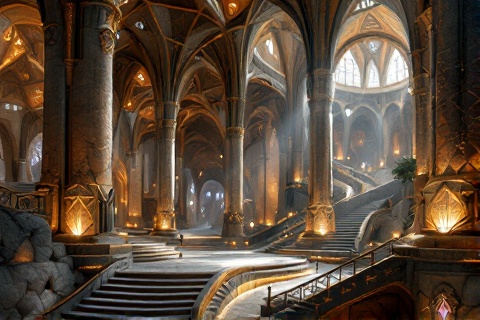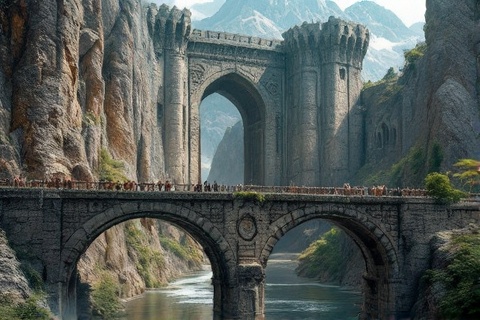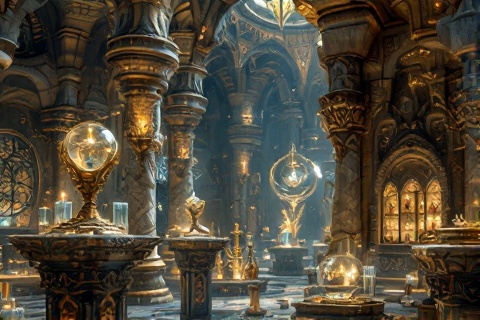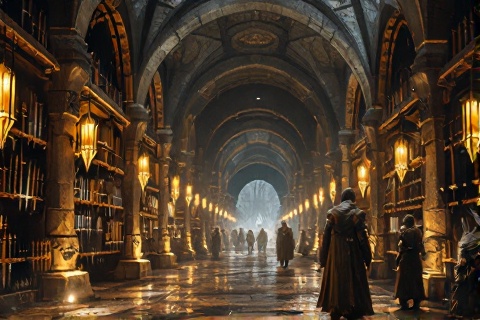
Nargothrond: The Hidden Fortress of Elven Kings
Unveiling the Mysteries, Legends, and Fall of Beleriand's Secret Stronghold
The Hidden Valley of Narog

Nargothrond stood in western Beleriand, carved into the high
banks where the river Narog cut through the plains of Talath Dirnen. The
fortress-city was situated approximately 50 leagues south of Tol
Sirion and lay west of the forests of Brethil, making it a
crucial stronghold between the northern realms and the havens of the Falas. The
natural geology of the region provided exceptional defensive advantages, with
steep cliffs and rocky hills forming a natural barrier against enemies.
The river Narog played a vital role in concealing and protecting Nargothrond.
The swift-flowing waters carved deep gorges through the hills, and the main
entrance to the fortress was set high in the cliff face above the river's
western bank. The rushing waters not only provided a natural moat but also
masked any sounds from within the fortress, while the steep riverbanks made
approach difficult for any attacking force.
The location of Nargothrond held immense strategic value during the First
Age of Middle-earth. It controlled the
southern passages between the lands of Turgon and the havens of
Círdan, while also guarding against threats
from the east where Morgoth's forces frequently attempted
to penetrate the defenses of the Elven realms. The fortress
served as a crucial buffer between the northern territories and the southern
regions of Beleriand, allowing the Noldor to maintain
communication and trade routes throughout their realms.
Architecture of the Great Halls

The main halls of Nargothrond were vast chambers carved deep into the living
rock, following the natural caverns but expanded and refined through centuries
of careful stonework. The central hall, where Finrod
Felagund held court, was renowned for its soaring
ceilings supported by intricately carved pillars that seemed to grow from the
very rock itself. The network of halls extended for many leagues within the
hills, arranged in levels that descended deeper into the earth.
The Noldorin craftsmen who built Nargothrond brought with them the architectural
expertise learned in Valinor. They employed sophisticated
techniques to create smooth walls that gleamed like glass, adorned with delicate
traceries that caught and amplified light. The stonework featured mathematical
precision in its geometric patterns, while maintaining organic flowing lines
that mimicked natural formations.
The builders of Nargothrond masterfully incorporated the existing cave systems
into their design. Natural caverns were enlarged and reinforced, while
maintaining their original character. Underground streams were channeled to
provide fresh water throughout the fortress, and natural chimneys in the rock
were adapted for ventilation. The integration was so seamless that it was often
impossible to distinguish where nature's work ended and elven craft began.
The defensive engineering of Nargothrond was unparalleled among the elven
realms. The main approaches were carefully hidden, with multiple gates and
checkpoints that could be sealed in times of danger. The architects designed the
passages to confuse and disorient intruders, with many false corridors and dead
ends. The few entrances were disguised among the natural features of the cliffs,
making them nearly impossible to spot without guidance.
The Gates and Bridges

The great doors of Nargothrond were masterworks of Noldorin engineering and
craftsmanship. Constructed of thick hardwood reinforced with steel and enchanted
with protective spells, they could withstand tremendous force. The doors
featured complex locking mechanisms that could be quickly activated in case of
attack, and they were designed to blend seamlessly with the rock face when
closed.
The main bridge spanning the Narog was a marvel of elven architecture. Built of
stone and steel, it connected the western bank to the hidden entrance of the
fortress. The bridge was designed to be quickly destroyed if needed, with
strategic weak points that could be targeted to prevent enemy access. Under
normal circumstances, it appeared as a natural stone formation to unfamiliar
eyes.
Throughout Nargothrond ran an intricate network of secret passages and escape
routes. These hidden ways were known only to the ruling family and trusted
advisors, providing multiple paths to reach the surface in case of emergency.
Some tunnels led to concealed exits in the surrounding hills, while others
connected to hidden chambers where supplies were stored for times of need.
The Royal Quarters
The royal quarters of Nargothrond occupied the highest levels of the fortress,
carved into the rock where natural light could still reach through carefully
designed shafts. The residence of Finrod Felagund, and later Orodreth, consisted
of a series of interconnected chambers that combined both private spaces and
areas for conducting official business. The layout emphasized security while
maintaining the elegance expected of an elven court.
The decoration of the royal chambers reflected the highest achievements of
Noldorin artistry. Walls were adorned with tapestries depicting scenes from
Valinor and the great deeds of the Noldor, while intricate mosaics of precious
stones caught and reflected light throughout the chambers. Carvings and
sculptures celebrated the natural world and the history of the elves.
The private chambers included sleeping quarters, studies, and meditation rooms
designed for solitude and contemplation. The council rooms were larger spaces
arranged to accommodate both small, private meetings and larger gatherings of
advisors. These chambers featured acoustic properties that allowed for clear
communication while preventing sound from traveling to unwanted ears.
Treasuries and Craftshalls

The treasure chambers of Nargothrond were legendary, housing vast collections of
precious metals, gems, and artifacts accumulated through trade and craft. These
vaults lay in the deepest levels of the fortress, protected by multiple layers
of security and magical wards. The wealth of Nargothrond was not merely stored
but artfully displayed, creating underground galleries that rivaled the
treasuries of Menegroth.
The forges and workshops of Nargothrond represented the pinnacle of Noldorin
craft. These spaces were equipped with sophisticated tools and facilities for
metalworking, jewel-crafting, and other artistic pursuits. The workshops were
arranged in a hierarchy, with master craftsmen occupying the most prestigious
spaces where they could work on their finest creations.
Throughout the halls of Nargothrond, displays of Noldorin craftsmanship
showcased the realm's artistic achievements. Galleries exhibited masterworks of
jewelry, weapons, and decorative arts created by the realm's most skilled
artisans. These displays served both as a testament to the realm's cultural
achievements and as inspiration for younger generations of craftsmen.
Living Quarters and Common Areas
The residential districts of Nargothrond housed thousands of elves in
comfortable quarters arranged according to family groups and social status.
Living spaces were carved into the rock walls in tiers, with walkways and stairs
connecting different levels. Each family unit had private chambers with access
to shared facilities, and the design ensured both privacy and community
interaction.
Communal spaces were carefully planned to foster social interaction and cultural
activities. Great halls served as gathering places for festivals, performances,
and daily meetings. These spaces featured excellent acoustics for music and
poetry recitals, which were integral to the life of the fortress-city.
Despite being underground, the architects of Nargothrond created spaces of great
beauty and light. Gardens were cultivated in large caverns where light was
channeled through crystal shafts, allowing plants to grow. Light wells were
strategically placed throughout the complex, using mirrors and polished surfaces
to bring natural illumination deep into the fortress.
The Deep Armories

The armories of Nargothrond contained vast stores of weapons and armor crafted
by the realm's master smiths. These facilities were strategically placed near
the main defensive positions, allowing for quick access during emergencies. The
weapons reflected the high standards of Noldorin craftsmanship, with each piece
being both beautiful and deadly effective.
Training grounds were established in both indoor and outdoor locations, where
the warriors of Nargothrond maintained their combat skills. The indoor
facilities included practice rooms with high ceilings for weapons training,
while outdoor areas were discreetly located in protected valleys near the
fortress. These grounds were essential for maintaining the realm's military
readiness.
The defensive infrastructure included numerous guard posts positioned throughout
the fortress, with particular attention paid to the approaches and potential
weak points. Watch stations were equipped with signal systems to quickly
communicate threats, and each defensive position was designed to support others
in case of attack. Storage rooms near these posts contained supplies and
equipment necessary for extended periods of defense.
